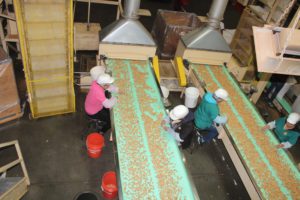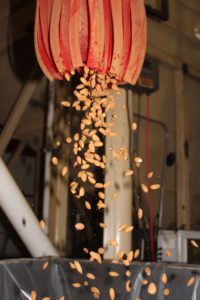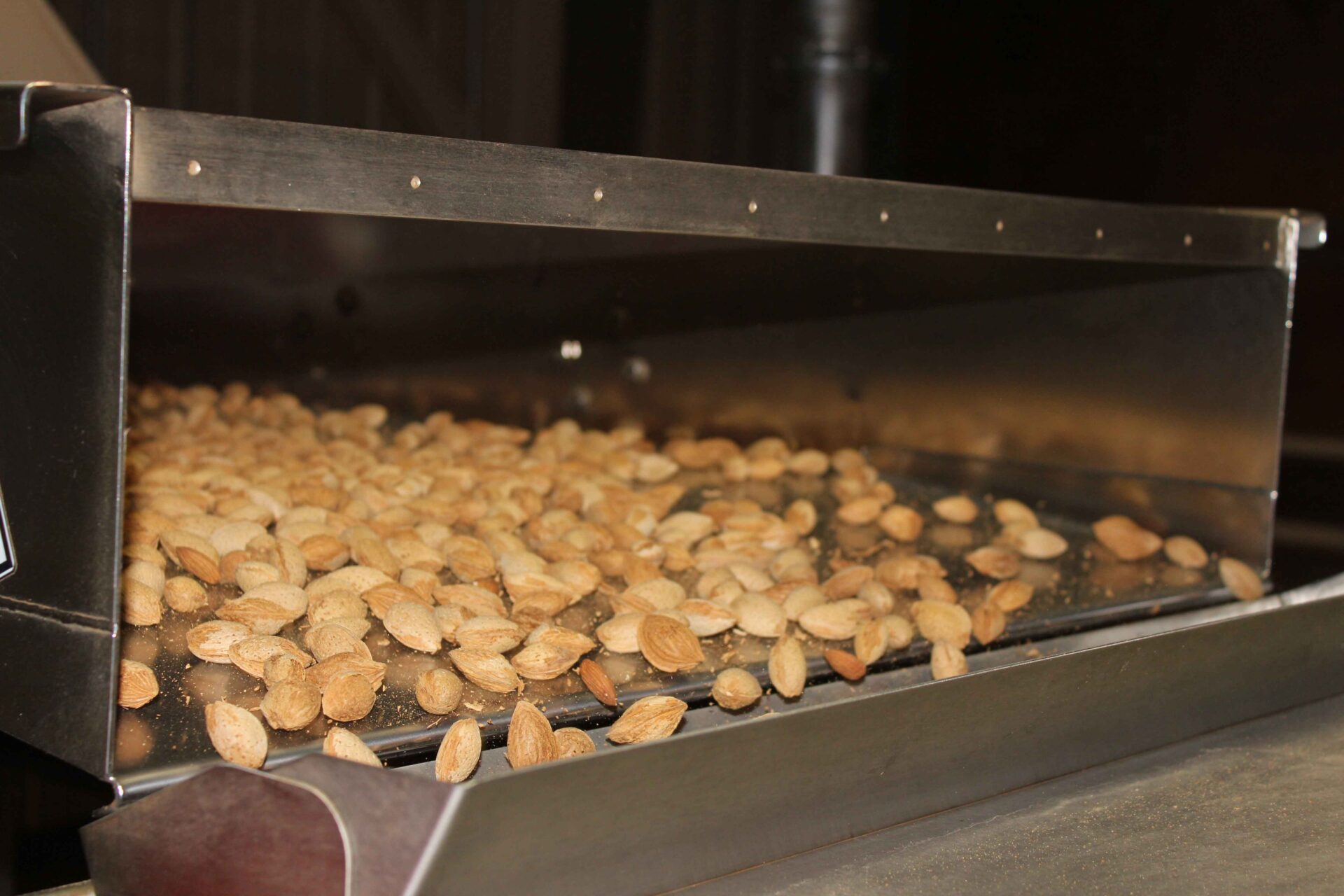New technology is expensive, but many times it is worth the investment because of the resulting savings in time, efficiency and improved product.
Electrical Systems
Electrical systems have been greatly improved in recent years by the use of PLC’s (Programmable Logic Controllers).
PLC’s allow huller/sheller operators to initiate operation of all equipment with a single control. Additionally, future equipment can be added by simply changing the PLC program. Changing the program easily allows sequencing of equipment start-up and shut down.
Precleaning
Precleaning of field harvested almonds has been improved with the advent of receiving pit vibrating feeder/scalpers. This equipment allows the operator to discharge the almonds directly onto the feeder/scalper without clogging stationary pit grates.
The feeder/scalper also removes sticks and other large foreign material, which in turn, protects the downstream equipment.
John Dyrseth, owner of San Joaquin Systems in Modesto, California, said the benefits to updating the precleaning equipment would be:
- Increased speed
- Reduction in equipment maintenance because it removes a lot of the trash
- Improved efficiency of the precleaner
- Increased volume
And the more volume that’s moved through, the faster the ROI (return on the investment) of the equipment, Dyrseth said.

Vibrating Scalping Screens
Hulling and shelling classification of inshell/inhull volumes have been dramatically improved through the introduction of large vibrating screeners. These large screeners allow increased volumes to be processed.
The use of vibrating scalping screens has also improved the removal of half-hulls from almond meat streams. These vibrating screen scalpers are available in lengths exceeding 100 feet to accommodate most huller/sheller configurations. The continuous scalping of half-hulls from the meat stream enhances the final meat cleaning systems and quality.
Larger vibrating screens also reduce the footprint in the plant, Dyrseth said. What this means is, one larger machine replaces the need for two machines and takes up less space in the facility.
More volume can also be moved with one larger machine, than two smaller machines.
Conditioning Systems
Almond hull quality has been improved with the incorporation of conditioning systems. Twigs, and fine and large shells are removed through these systems to reduce the fiber content in the finished hull product. Additionally, loose almond meats are recovered from the hull stream, which reduces the cost of these systems.
This improvement has been added recently, and it’s never been done before, Dyrseth said.
“The benefits are that they reduce the fiber in the hull,” Dyrseth said.
The reduced fiber in the hull is beneficial because currently only 15 percent fiber is allowed, and after that they are sold at a reduced price, Dyrseth explained.
Besides removing twigs and fine shell, it removes loose meats—this can’t be avoided as some meats are lost in the hulling process, Dyrseth said.
In the past, those meats would normally go into the hull pile and be sold as cattle feed. But now, the benefit of conditioning means those meats can be reclaimed, Dyrseth said.
There would also be better quality hulls, which in turn allows them to be sold at a premium price.

Barcoding
The use of computer systems with barcoding has allowed accurate tracking of incoming product and outgoing finished commodities. These computer tracking systems have reduced labor requirements and improved accuracy of record keeping and documentation.
Barcoding can isolate each grower, barcode the incoming load and track it all the way through the system, so that the paperwork at the end is all on a computer. This means instead of having sheets of paper being shuffled back and forth, it’s all scanned and it goes into a computer. This is a time reduction for office workers, and it’s more accurate with less chance for error.
Electronic Sorting
Vast improvements in electronic sorting has allowed huller/shellers to produce a clean inshell product at high volumes. The improved electronic sorters handle inshell at high volumes with a reduction of clean product going into the reject stream.
While electronic sorting machines have improved dramatically, they still haven’t reached the point that they have completely eliminated the need for human labor, Dyrseth said.
Most processors don’t solely depend on electronic sorters. They still have sorting belts where workers hand sort the nuts, Dyrseth said.
“I know of some processors who only use the sorting tables for some customers, especially the Japanese who insist that they go with a visible human eye,” Dyrseth said.
There is no question there has been a huge improvement in electronic sorting over the years, but that hasn’t eliminated the need for human sorters, Dyrseth said.
Better Quality Product
For huller/shellers these upgrades doesn’t really reduce labor, but they do increase efficiency and improve the product quality at the other end, Dyrseth said.
“As an example for, many years they would hull the product and produce inshell at very high percentages, and send it to Blue Diamond or whoever would do the final processing,” Dyrseth said.
“Now, with electronic sorters, they can produce inshell that is very good at the huller,” Dyrseth said, adding and the growers get premiums because the huller/shellers are able to produce inshell that requires very little cleanup at the processing end.
Upgrading equipment makes financial sense for huller/shellers because of the better quality product that is produced, and the fact that the equipment runs more efficiently. There is also less concern about shutdowns and equipment failure which means more product can be pushed through faster and cleaner.
“Years ago they probably ran for a month and a half to two months, and they’d run maybe a million pounds,” Dyrseth said.
Today, that’s all changed, especially for huller/shellers that run 100 million meat pounds a year. The equipment has to be more robust and be able to withstand the rigors of that kind of volume, Dyrseth said.
















